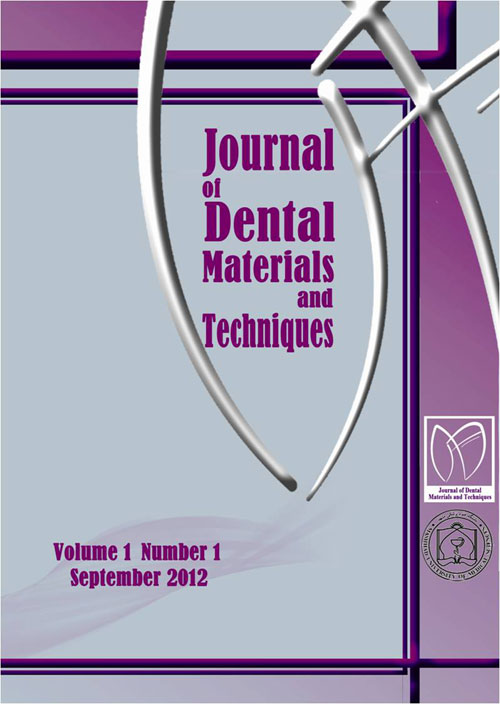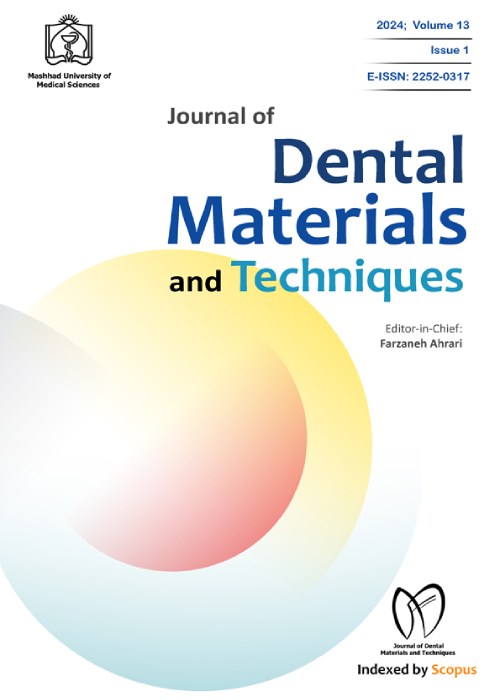فهرست مطالب

Journal of Dental Materials and Techniques
Volume:11 Issue: 3, Summer 2022
- تاریخ انتشار: 1401/07/12
- تعداد عناوین: 8
-
-
Pages 138-142Introduction
Marginal adaptation highly affects the long-term success of crowns. This study intends to investigate the marginal adaptation of monolithic zirconia and veneered zirconia crowns.
MethodsBased on our searches in PubMed and Google Scholar from 2011 to 2020, 22 articles were obtained, and after studying their full-texts. Five articles that were most related to our subject were selected.
ResultsIn almost all articles, the greatest mean marginal gap value was recorded for monolithic zirconia, whereas layered zirconia crowns demonstrated the lowest mean marginal gap values.
ConclusionBased on finding of the current study, monolithic zirconia restorations had a superior marginal adaptation than layered zirconia restorations. However, clinically both restorations have an acceptable marginal fit
Keywords: Monolithic zirconia restoration, Layered zirconia restoration, marginal adaptation, dental ceramic -
Pages 143-151Introduction
Despite the incredible popularity of dental composites, their application is associated with several difficulties, one of the most important of which is the microleakage phenomenon. Incorporation of silver nanoparticles in composites exerts antibacterial effects; nonetheless, the impact of silver nanoparticles on microleakage has not yet been studied. This research conducted to assess the effect of silver nanoparticles application as a precursor on the microleakage of composite-filled clV cavities using two different approaches of universal bond application.
MethodsSixty non-carious human molars were collected, and clV cavities were provided on the buccal surfaces. The samples were categorized to 4 groups (n=15 in each group) and were restored using four different methods. After placement in 2% basic fuchsin solution for 24 h, permeability was determined between the cavity wall and restorative material in the gingival and occlusal margins. Thereafter, one sample of each group was selected. After preparation, the specimens were analyzed using backscattered electron scanning electron microscopy. Finally, the cytotoxicity was assessed by the Methyl-thiazolyl-tetrazolium (MTT) assay.
ResultsIn both gingival and occlusal margins, if the silver nanoparticles were used, microleakage significantly decreased (P≤0.001). The addition of silver nanoparticles had no adverse effect on human gingival fibroblasts (HGF) cell viability.
ConclusionIt seems that the use of silver nanoparticles in the total-etch method can improve phosphoric acid penetration into dentinal tubules, increases the depth of etching, and promotes the bond quality
Keywords: ClV Restoration, Microleakage, MTT Assay, Silver nanoparticles, Universal Bond -
Pages 152-157IntroductionThis prospective double-blinded clinical trial study aimed to compare the direct and indirect techniques of inferior alveolar nerve block (IANB) anesthesia regarding positive aspiration and success rate.MethodsThis study included all 250 healthy patients who were referred to the Oral and Maxillofacial Surgery Department, Mashhad Dental School, Mashhad, Iran, for lower teeth extraction. The patients were randomly assigned to two groups. In total, 126 patients were subjected to IANB by a direct technique, and an indirect technique was utilized to perform IANB on the others. The primary and secondary outcomes were positive aspiration and anesthetic success, respectively. The data were statistically analyzed with SPSS software (version 19) using the Chi-square test.ResultsThe positive aspiration rates were 23 (18.3%) and 7 (5.6%) in the direct and indirect groups, respectively, which was statistically significant (P=0.002). The incidence rates of positive aspiration on the right and left sides were 13 (11%) and 17 (12.9%), respectively, which had no significant difference (P=0.651). Moreover, the success rates of direct and indirect techniques were 106 (84.1%) and 93 (75%) respectively, which was not statistically significant. It is worth mentioning that the success rates were similar on the right (79.7%) and left (79.5%) sides.ConclusionAccording to the established results, the indirect technique of IANB has a significantly less positive aspiration rate, compared to the direct technique. This advantage is especially valuable in high-risk patients undergoing inadvertent intravascular injection of an anesthetic drug, which can lead to catastrophic complications.Keywords: Aspiration, Inferior alveolar nerve block, local anesthetic, Mandible
-
Pages 158-167IntroductionThis study aimed to evaluate the treatment outcomes of patients with temporomandibular disorder (TMD).MethodsThis cross-sectional study examined records of 165 TMD patients who referred to the Department of Prosthodontics at the Dental School of Mashhad University of Medical Sciences, Iran, from 2012 to 2017. Patients were recalled and clinically reexamined for reduced signs and symptoms or total improvement. Treatment outcomes were characterized as “improved” and “not improved” in terms of clicking sound and pain in the joint. The data were analyzed using SPSS software (version 18) using the Chi-squared and Fisher's exact tests at a significance level of less than 0.05 (P<0.05).ResultsThe subjects included 53 males (32.1%) and 112 females (67.9%) with a mean ±SD age of 31.7 ± 13.6 years. The patients with a locked mandible and joint sounds while opening their mouth or chewing recovered significantly. Moreover, a significant association was found between improvement and the absence of the anterior slide, and patients without an anterior slide improved better than those with the anterior slide (P<0.05).ConclusionThe use of conservative methods in the treatment of TMD is highly recommended regardless of factors such as age, gender, and clinical symptoms.Keywords: Temporomandibular joint disorders, Treatment outcome, Pain, Stomatognathic System
-
Pages 168-177IntroductionThis randomized clinical study aimed to evaluate the clinical performance of composite and compomer materials in primary molars over two years.MethodsChildren aged five to six years with at least two carious proximal surface primary molars were screened for resin-hybrid composite (Kerr Herculite Classic) and compomer (Dyract XP and R&D Series Nova) restorations. The restorations were clinically evaluated after 3, 6, 9, 12, 15, 18, and 24 months using the modified United States Public Health Service criteria. Statistical analyses were performed using Chi-square, McNemar, z-tests, and Kaplan-Meier survival analysis. P<0.01 and P<0.05 values were considered statistically significant according to the test used.ResultsThe survival rates were 95.3% for Kerr Herculite Classic resin-based composite, 97.6% for Dyract XP, and 95.4% for R&D Series Nova compomer restorations with no statistically significant differences (P>0.05). No significant differences were observed between the three materials concerning retention, color matching, marginal discoloration, anatomic form, marginal integrity, secondary caries, and surface texture (P>0.05). No statistically significant differences were also found between the effects of the cavity type, the tooth position in the arch, the age of the patient, the restorative material, and the lining material on the survival rates of the teeth (P>0.05). Restoration loss was higher in males than females, and a statistically significant relationship was observed in terms of gender (P=0.017). Restoration loss in the first primary molars (8.3%) was greater than that in the second primary molars (6.7%) (P=0.041).ConclusionBoth composite and compomer restorations were clinically successful over two years.Keywords: Child, Compomers, Composite resins, Dental Restoration Failure
-
Pages 178-184IntroductionOne of the major factors affecting dentists’ manual dexterity is their sitting position while performing dental procedures. The training patterns in dentistry schools are mostly established in accordance to right-handed (RH) students. The present pilot study aimed to compare the RH and left-handed (LH) students in terms of their performance in restorative cavity preparation while operating from both right-side and left-side positions.MethodsA total of 24 students, comprising of 12 RH and 12 LH students, were enrolled. The selected students were to prepare a mesio-occlusal cavity on acrylic maxillary, mandibular, right and left first molars. Their performance was rated by three dental specialists based on predetermined indices for ideal Class-II restorative preparation. Parametric statistical tests, including paired-sample t-test and independent t-test, were used to compare the students' performance.ResultsBased on the results, RH students exhibited significantly better performance on their ideal side. The LH students' performance was better on their ideal side and this difference in performance was significant only while preparing the mandibular molars (P<0.05). The difference in the performance of the LH students on their ideal and non-ideal sides was less than that of the RH ones. A comparison of the mean scores of the RH and LH students in the two right-side and left-side positions showed no statistically significant difference.ConclusionThere was no difference between the LH and RH students' skills in restorative preparation in their ideal posture. The LH students showed considerable improvement in their performance when working on their ideal posture.Keywords: Dental Cavity Preparations, Dental Student, Handedness
-
Pages 185-191IntroductionWe compared the effects of chlorhexidine (CHX), sodium hypochlorite (NaOCl), and ethylene diamine tetra-acetic acid (EDTA) root canal irrigants on the pushout bond strength of Resil experimental sealer and AH26 to root dentin.MethodsIn this in vitro study, 65 teeth were assigned to six groups based on the choice of final irrigant and sealer: (I) CHX and AH26, (II) CHX and Resil, (III) NaOCl and AH26, (IV) NaOCl and Resil, (V) NaOCl plus EDTA and AH26, and (VI) NaOCl plus EDTA and Resil. The teeth were decoronated and underwent chemomechanical preparation. In each group, half of the root canals were filled with AH26 and the other half with Resil plus gutta-percha by the lateral compaction technique. In the control group, the root canals were rinsed with saline and obturated without sealer. The roots were sectioned perpendicular to the longitudinal tooth axis at 3, 7, and 11 mm from the apex (apical, middle, and coronal thirds). The pushout bond strength of sealer to root dentin was measured by a universal testing machine and recorded in Newtons (N).ResultsAH26 plus CHX, as well as AH26 plus NaOCl and EDTA, yielded the maximum pushout bond strength (P<0.05). The pushout bond strength in the apical third was higher than that in the middle and coronal thirds. The mean pushout bond strength of both sealers in NaOCl irrigation groups was lower than that in CHX and EDTA plus NaOCl groups.ConclusionResil experimental sealer had a lower pushout bond strength than AH26.Keywords: AH26, Push-out Bond Strength, Resil
-
Pages 192-200IntroductionThis study aimed to investigate the antimicrobial efficacy of chelation agents on Enterococcus faecalis (E. faecalis) and Candida albicans (C. albicans) when used alone or in combination with propolis.MethodsOne hundred fifty mandibular premolar teeth were selected. Each canal was prepared with Reciproc R25. The roots were then divided into two parts along their long axis (n=300). For E. faecalis and C. albicans, the samples were divided into 16 groups (14 experimental and 2 control) as follows: Group 1A-1B [17% Ethylenediaminetetraacetic acid (EDTA)], Group 2A-2B [10% Citric Acid (CA)], Group 3A-3B [1% phytic acid/inositol hexaphosphate (IP6)], Group 4A-4B (17% EDTA+8 mg/mL propolis), Group 5A-5B (10% CA+8 mg/mL propolis), Group 6A-6B (1% IP6+8mg/mL propolis), Group 7A-7B (8 mg/mL propolis), Control A-B (Dimethyl Sulfoxide). Each tooth was randomly irrigated with 2 mL of one of the group solutions or dispersions for 5 min, and the solutions were examined for the bactericidal effect.ResultsFor C. albicans, all groups showed less optical density (OD) than the control group (P<0.05). The propolis group and the IP6 group had higher OD values than the CA group (P<0.05). For E. faecalis, on the other hand, significantly lower OD values were observed in the propolis+ CA group, compared to the CA and propolis groups (P<0.05). There was no significant difference between microbial growth among IP6, EDTA, propolis+ CA, propolis+IP6, and propolis+ EDTA groups (P>0.05).ConclusionCA and IP6 showed promising results in eliminating E. faecalis, one of the collective organisms responsible for failed root canals.Keywords: Antimicrobial efficacy, citric acid, EDTA, endodontic microbiology, phytic acid


